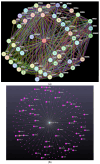Divergent Processing of Cell Stress Signals as the Basis of Cancer Progression: Licensing NFκB on Chromatin
- PMID: 39201306
- PMCID: PMC11354898
- DOI: 10.3390/ijms25168621
Divergent Processing of Cell Stress Signals as the Basis of Cancer Progression: Licensing NFκB on Chromatin
Abstract
Inflammation is activated by diverse triggers that induce the expression of cytokines and adhesion molecules, which permit a succession of molecules and cells to deliver stimuli and functions that help the immune system clear the primary cause of tissue damage, whether this is an infection, a tumor, or a trauma. During inflammation, short-term changes in the expression and secretion of strong mediators of inflammation occur, while long-term changes occur to specific groups of cells. Long-term changes include cellular transdifferentiation for some types of cells that need to regenerate damaged tissue, as well as death for specific immune cells that can be detrimental to tissue integrity if they remain active beyond the boundaries of essential function. The transcriptional regulator NFκB enables some of the fundamental gene expression changes during inflammation, as well as during tissue development. During recurrence of malignant disease, cell stress-induced alterations enable the growth of cancer cell clones that are substantially resistant to therapeutic intervention and to the immune system. A number of those alterations occur due to significant defects in feedback signal cascades that control the activity of NFκB. Specifically, cell stress contributes to feedback defects as it overrides modules that otherwise control inflammation to protect host tissue. NFκB is involved in both the suppression and promotion of cancer, and the key distinctive feature that determines its net effect remains unclear. This paper aims to provide a clear answer to at least one aspect of this question, namely the mechanism that enables a divergent response of cancer cells to critical inflammatory stimuli and to cell stress in general.
Keywords: BET inhibitor; cell stress; chemokines; chromatin; cytokines; histone; inflammation; nuclear factor kappa B; super enhancer; unfolded protein response.
Conflict of interest statement
The author declares no conflict of interest.
Figures






Similar articles
-
NFkappaB-dependent signaling pathways.Exp Hematol. 2002 Apr;30(4):285-96. doi: 10.1016/s0301-472x(02)00777-4. Exp Hematol. 2002. PMID: 11937262 Review.
-
Signaling via the NFκB system.Wiley Interdiscip Rev Syst Biol Med. 2016 May;8(3):227-41. doi: 10.1002/wsbm.1331. Epub 2016 Mar 16. Wiley Interdiscip Rev Syst Biol Med. 2016. PMID: 26990581 Free PMC article. Review.
-
[Free radicals and antioxidants: physiology, human pathology and therapeutic aspects (part II)].Therapie. 1998 Jul-Aug;53(4):315-39. Therapie. 1998. PMID: 9806002 Review. French.
-
MDM2 beyond cancer: podoptosis, development, inflammation, and tissue regeneration.Histol Histopathol. 2015 Nov;30(11):1271-82. doi: 10.14670/HH-11-636. Epub 2015 Jun 11. Histol Histopathol. 2015. PMID: 26062755 Review.
-
A20, an essential component of the ubiquitin-editing protein complex, is a negative regulator of inflammation in human myometrium and foetal membranes.Mol Hum Reprod. 2017 Sep 1;23(9):628-645. doi: 10.1093/molehr/gax041. Mol Hum Reprod. 2017. PMID: 28911210
Cited by
-
Investigating the biology of microRNA links to ALDH1A1 reveals candidates for preclinical testing in acute myeloid leukemia.Int J Oncol. 2024 Dec;65(6):115. doi: 10.3892/ijo.2024.5703. Epub 2024 Nov 8. Int J Oncol. 2024. PMID: 39513593 Free PMC article. Review.
-
ALDH1A1 in breast cancer: A prospective target to overcome therapy resistance (Review).Oncol Lett. 2025 Mar 4;29(5):213. doi: 10.3892/ol.2025.14959. eCollection 2025 May. Oncol Lett. 2025. PMID: 40093866 Free PMC article. Review.
-
Expression of Aldehyde Dehydrogenase 1A1 in Relapse-Associated Cells in Acute Myeloid Leukemia.Cells. 2025 Jul 7;14(13):1038. doi: 10.3390/cells14131038. Cells. 2025. PMID: 40643557 Free PMC article. Review.
-
TNF-α Activates NF-κB Signalling Pathway in MG-63 Cells on Titanium and Zirconia Implant Surfaces.Materials (Basel). 2025 Feb 18;18(4):884. doi: 10.3390/ma18040884. Materials (Basel). 2025. PMID: 40004407 Free PMC article.
-
Potential Strategies for Overcoming Drug Resistance Pathways Using Propolis and Its Polyphenolic/Flavonoid Compounds in Combination with Chemotherapy and Radiotherapy.Nutrients. 2024 Oct 31;16(21):3741. doi: 10.3390/nu16213741. Nutrients. 2024. PMID: 39519572 Free PMC article. Review.
References
-
- Lu H., Chen R., Barnie P.A., Tian Y., Zhang S., Xu H., Chakrabarti S., Su Z. Fibroblast Transdifferentiation Promotes Conversion of M1 Macrophages and Replenishment of Cardiac Resident Macrophages Following Cardiac Injury in Mice. Eur. J. Immunol. 2020;50:795–808. doi: 10.1002/eji.201948414. - DOI - PubMed
-
- Naitoh H., Suganuma Y., Ueda Y., Sato T., Hiramuki Y., Fujisawa-Sehara A., Taketani S., Araki M. Upregulation of Matrix Metalloproteinase Triggers Transdifferentiation of Retinal Pigmented Epithelial Cells in Xenopus Laevis: A Link between Inflammatory Response and Regeneration. Dev. Neurobiol. 2017;77:1086–1100. doi: 10.1002/dneu.22497. - DOI - PubMed
-
- Gaba A., Grivennikov S.I., Do M.V., Stumpo D.J., Blackshear P.J., Karin M. Cutting Edge: IL-10-Mediated Tristetraprolin Induction Is Part of a Feedback Loop That Controls Macrophage STAT3 Activation and Cytokine Production. J. Immunol. 2012;189:2089–2093. doi: 10.4049/jimmunol.1201126. - DOI - PMC - PubMed
-
- Stedile M., Lara Montero A., García Solá M.E., Goddio M.V., Beckerman I., Bogni E., Ayre M., Naguila Z., Coso O.A., Kordon E.C. Tristetraprolin Promotes Survival of Mammary Progenitor Cells by Restraining TNFα Levels. Front. Cell Dev. Biol. 2023;11:1265475. doi: 10.3389/fcell.2023.1265475. - DOI - PMC - PubMed
Publication types
MeSH terms
Substances
LinkOut - more resources
Full Text Sources
Medical

